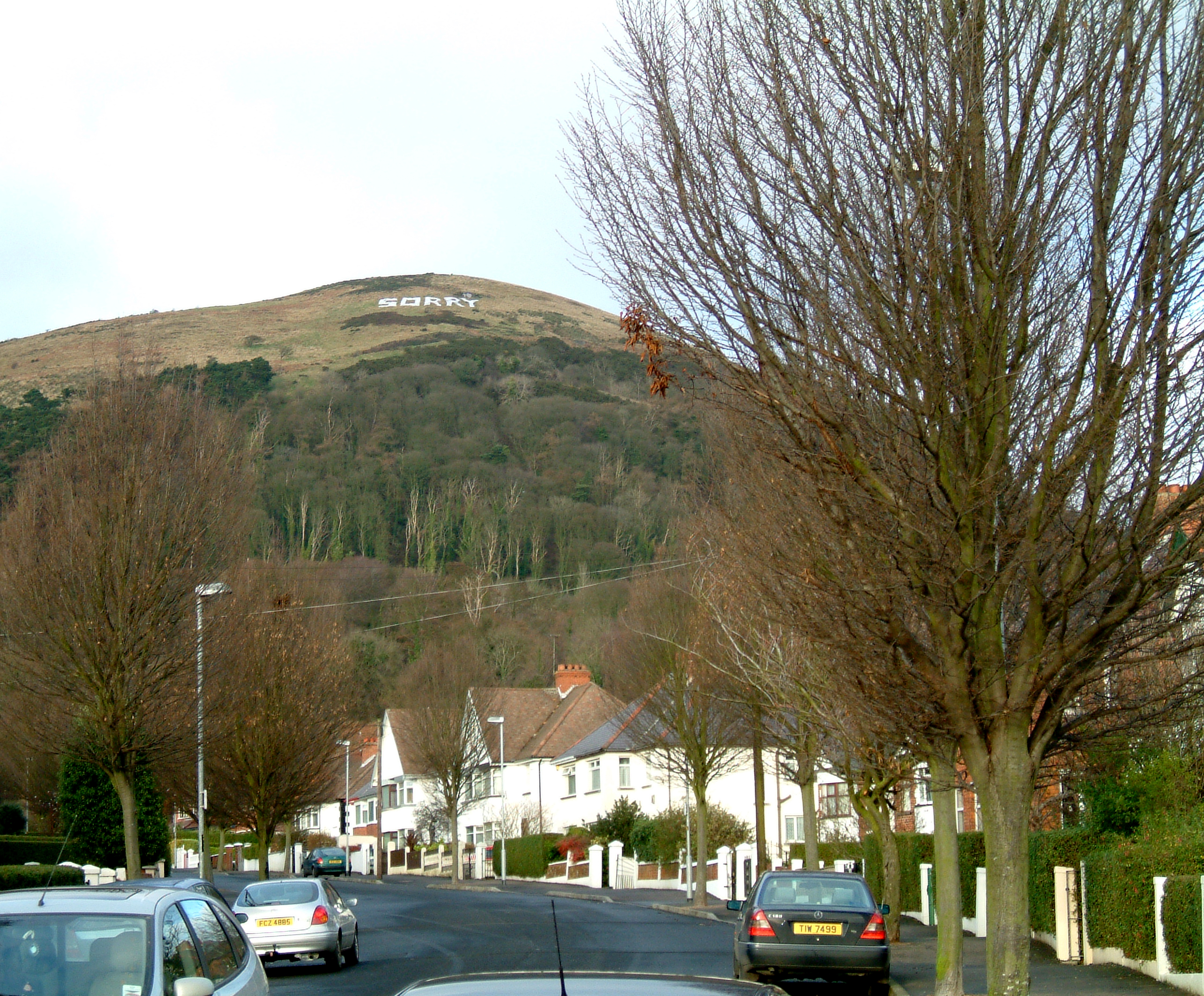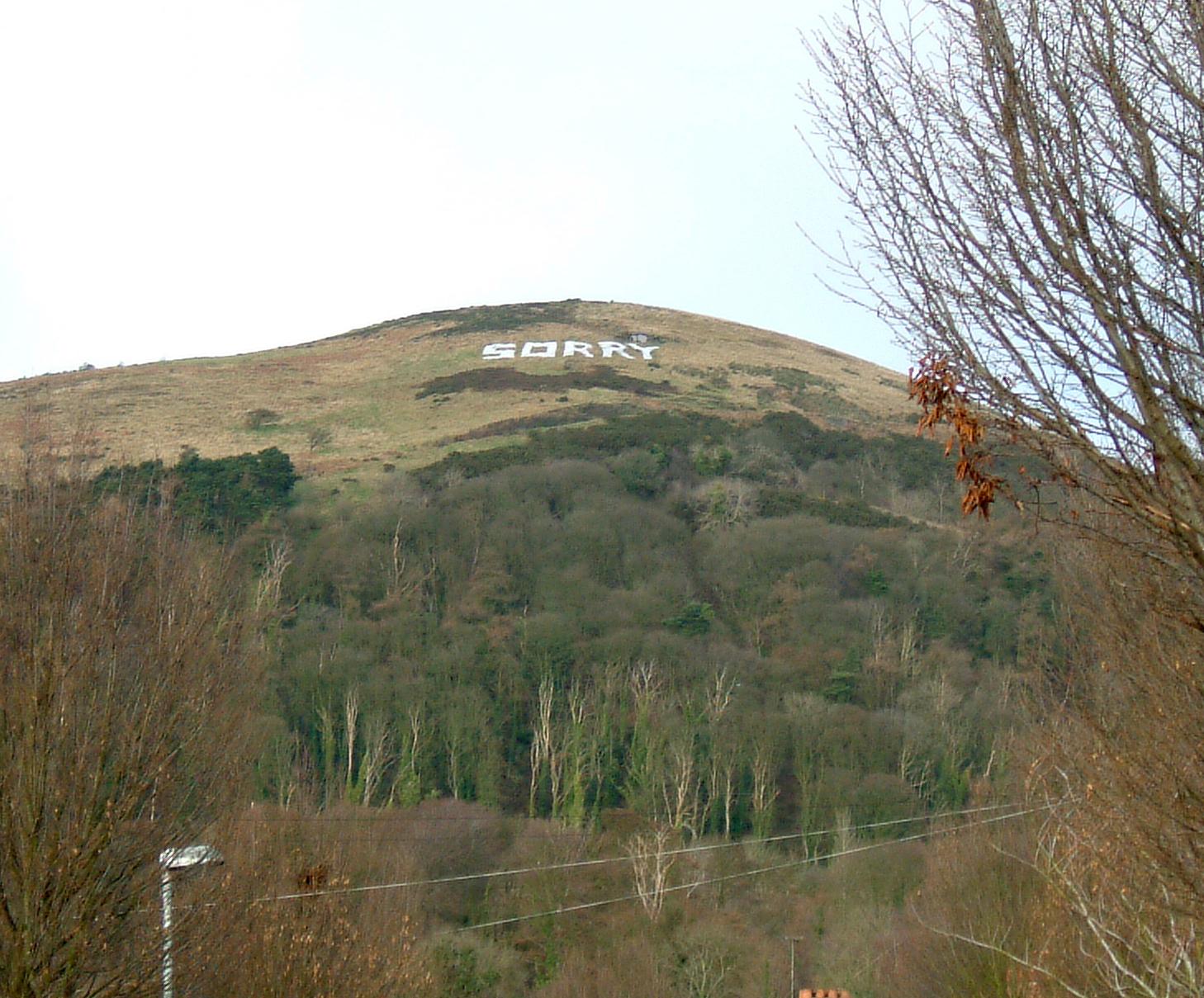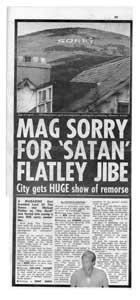

Sorry intervention (Cave Hill)
This is the text of a talk I gave on this work for Household - 11years after the event.
(NB: there was a handout of images that are referred to but I can't present here):
Out in The Open, Bus Tour - Household - 4th Oct 2015
Been asked to about an intervention I made in 2004.
So it was large scale text a 40m x 14m – plastic sheeting pegged out on the hillside.
I’m going to speak about the trigger for this work. How it came about – the impetus for the work. So I will tell you the backstory – but then I want to critique that a little bit because I think it’s important as to how we encounter and talk about art
especially art in the public-realm which de-facto exists without access to the backstory or frame of the artworld because the wider public encounters it
and because it sits amongst the all other things, images and ideas in the world about us the broader aesthetic field.
How it came about.
This is the "backstory" (Fuller story below)
THE VACUUM: CITY COUNCIL FUNDED Satirical magazine
btw: I see the Vacuum (pg 2) in it’s heyday as one of the best public works in Belfast.
Situation was around the paired GOD / SATAN issues which the CITY COUNCIL – took offence to.
Which has a majority of religious right conservative city councilors who took offence. I guess they didn’t think this was the kind of thing they wanted their money spent on…
Demanded a public apology for any offence occurred – even though they could not produce evidence of any offence…. And illegally threatened to withdraw pledged funding.
As part of their campaign the Vacuum organized a Sorry Day – a day of ironic protest.
As part of the protest Richard West asked if I would climb CITY HALL and install a SORRY banner.
BUT – I didn’t want to climb the city hall to put up a SORRY banner. Why Not? I guess I saw that as a predictable stunt. The kind of activism that has a rightful place – but that I feel often ends up as loudhailer style activism – which becomes in Foucault’s terms the resistant force that paradoxically supports the status quo.
BUT more so - I saw an opportunity to make a public artwork – that for me would exist differently from activist support for a cause. And that’s where I determined to make the Sorry text intervention.
Below all this is a question of what is the relationship of art to the political? – or what is the political agency of art? – and also in a wider sense what is the agency of art?
I was aware of the Black Mountain being used in the 70’s 80’s as a political message board. E.g. Support Dessie Ellis (image pg5.). And Good Friday Referendum YES / NO campaigns in the mid 90’s.
I figured a different kind of intervention would work against the background of those practices and so I chose Cave Hill to avoid the direct loaded-ness of the West Belfast hills and its positioning of a generally republican leaning.
I’m not pro-Republican or pro-Unionist – especially so when it manifests as a form of oppression – which unfortunately is quite often.
Ok so let’s look at the term ‘SORRY’ – it’s kind of an ultimate passive aggressive (This was the approach of the Vacuum’s Sorry Protest)
I AM SORRY, I AM NOT SAYING SORRY.
I AM SORRY, I AM NOT SAYING SORRY
SORRY, I’M NOT SAYING SORRY.
SORRY, I’M NOT - SAYING SORRY
I’M NOT - SAYING SORRY - I’M NOT - SAYING SORRY
NOT SAYING SORRY - NOT SAYING SORRY - NOT SAYING SORRY
NOT SAYING SORRY
NOT - SAYING - SORRY
x repeat - repeat as required
Also the refusal to say Sorry has been intensely political in NI history (e.g. Bloody Sunday, Bloody Friday etc.)
But to say SORRY is really very much an interpersonal exchange and in a broad sense out of context not identifiably about a formulated position or cause. In this common usage it can invoke HUMOUR as a form of mediation between parties and aims to offer an inter-subjective moment. Saying sorry sincerely also needs a specific reason – a purpose – to identify what someone is sorry for – it relates to a grievance – a perceived victim and a perceived perpetrator.
The public-ness of the hillside enabled my Sorry to be encountered by many people in the city – beyond those who were within the context of Vacuum / City Council wrangle – and so they were not furnished with that story as the specific reason for an apology. That public-ness was unlike the technological framed public-ness of WISH (pg. 3) which could only be seen mediated through the media or from privileged height (best seen from helicopter, drone or aircraft). Also it might be added, the WISH was loaded with a prescribed saccharin and infantilized message about Northern Ireland’s tragic wish for the future. The less said the better….
Ok so lets rewind - most people in the artworld who reference this work do so in terms of the backstory - and I am also guilty in peddling the back story…..it’s a problem of my own making.
In a common sense it would seem the activism-ness of my SORRY appears political in relation to the backstory – and furthermore it possibly carried the ‘correct sort of politics’ supporting freedom of expression against an oppressor (interestingly; the philosopher Benjamin in The Author as Producer (1934), problematically in my view in terms of today’s myriad of competing social relations, asserts that the artist must choose the ‘correct political tendency’ - a term we’ll come back to later).
And also the backstory has helped generate a lot of artworld interest for this work (from writers, curators, collectors even etc. – probably the invite to speak in this programme was due to the backstory) The art-world has a need for words – and the backstory of SORRY has a currency in that context. But this artworld wordy-ness is a problem for art in public.
I have a problem with this established rationale – what the work has become ‘about’. I have a problem with it in terms of the ‘political’ in relation to the agency of art. But I’ll try tease this out from a very artists point of view here.
Chantal Mouffe’s assertion is that all art is possibly political (as she argues that it is not useful to make a distiction between 'political' and 'non-political art'). However she also states that much art overtly claiming to be political might be the least effective (and perhaps likely counteractive) and at the same time that a lot of art is complicity passive in terms it’s political direction and therefore it helps form the status quo. Ultimately she posits art’s political agency within its critical aesthetic agency – the capacity of the aesthetic experience to circumvent the hegemonic and motivate people’s sense of the political - by being different - exercising difference. Importantly, she does not separate the aesthetic from the politic in this sense.
OK - So here she’s taking about the actual encounter with art not purely the message it delivers.
So with SORRY we need to go back to the encounter – not the backstory.
The majority of people encountering the SORRY piece would not have been within the bubble of knowing about the Vacuum sorry. They would have encountered the SORRY without the framework of the Vacuum’s protest. (Also with subsequent encounters when I’ve shown images of the work outside of the vacuum context).
So the real encounter in that case was not prescribed with the backstory linking it to the Vacuum / City Council. This direct encounter was not prescribed – there was an open-ness involved with it that allowed the viewer freedom – and the ability to practice freedom – or perhaps agitate the viewer into asking, wondering, questioning. Who is sorry, For what? Are they sorry too? Am I sorry?
SORRY SORRY SORRY
SORRY
SORRY
SORRY SORRY SORRY SORRY high higher higher
SORRY SORRY SORRY
SORRY
SORRY
SORRY SORRY SORRY low slow whisper etc.
SORRY
....continue with that until you want to continue with this:
So the problem is with how the given rational for the work short-circuits this encounter – and is at least misleading to the artworks’ potential agency. And especially so the given backstory wasn’t what the general public had possession of. So if we stick to the rationale of the backstory we never escape the artworld bubble.
This short-circuit (typical of art writing) reduces art to a kind of placeholder or shortcut to a prescribed one-dimensional message – which renders the viewer away from their own experience – and dis-empowers the viewer from that potential (a common strategy of Neo-liberal cultural production – to limit the scope for individual agency).
This is on the whole is what happens with the other more recent texts on the hillsides (e.g. Gael Force – pgs. 7 & 8). Which incidentally also territorialize that space with a kind of authority – a political authority – which presents a ‘correct political tendency’. I do however love seeing these texts – they are fantastic and impressive. But, for me - they operate in a less interesting way.
For me the SORRY work is not ‘about’ anything as such – but rather a practice of art-freedom. Freedom for me as an artist and also for the viewer. It carried my usual crave for escapde and problem solving – can I do that? How do I do that? Who is allowed to do that? And in this questions the authority of permissions (whether the permission relates to legal permission – the governmental authority or to territorialized permissions – control over who - speaks what - from where).
I guess from this work I would advocate for artists to claim public (and private) space and practice autonomy and freedom in how they make art there. The more un-authorised, unsanctioned and unprescribed art there is – the better.
That way we may avoid the prescription of public space around narrow neoliberal dynamics and in this way I think art can embody the political space - rather than be a placeholder or sign post to entrenched positions.
An anarchic approach.
I think too that this is what the Vacuum magazine itself did brilliantly through its publications.
Finally, the possible legacy of this seems to be a re-activation of the hills for large scale texts again. And this is great.
Worth noting in respect to that is Christoff Gillen’s IMAGINE A CITY OF EQUALS in 2008. (pg. 6) Which whilst falling guilty of rendering a prescribed and slightly banal message did, during its process, manage to produce a powerful effect of intrigue before the final message was clear. Christoff’s work, probably more than mine, acted to re-activate the regular use of the hills for such messaging.
Thank you for coming on the bus tour and listening.
Original backstory in full (as I know it):
During 2004 Belfast City Council demanded that the cultural newspaper The Vacuum apologised to ‘the citizens of the City' and ‘Members of the Council' for ‘any offence which may have been caused by previous publications'.
It was in response to the paired issues of the publication entitled “God” and “Satan”.
The demand for an apology was backed by an arguably illegal threat to withdraw pledged funding.
The Council could not identify what in the two issues had caused offence nor could they produce evidence of the complaints. It seemed clearly a blatant attempt to stifle freedom of expression (which in this instance pertained to comedic agitation around issues of Christianity where it shapes the culture in which we live) by the conservative religious right who made up the majority of city councilors.
In response The Vacuum organised an ironic day of "apology". (see. www.sorryday.com) with the help of its' supporters which included a march through the city of supporters carrying "sorry" placards and banners and a " Sorry Santa " as it was Christmas time.
I planned and executed a project to say “sorry” from the top of Cave Hill - a hill top visible from most parts of Belfast .
The close-by hills around Belfast have a history of republican and loyalist “pronouncements” e.g. protests to free political prisoners and statements in relation to the referendum on the Good Friday Agreement (YES / NO). More recently they have been used in more general political activism.
The text was 15m high and 40m wide, made of plastic sheets and pegged with bamboo canes.
The Sun, a tabloid newspaper covered the “ sorry” day with typically hyperbolic but humorous reporting...
Documentation of the intervention has been made into a photographic work:
Untitled landscape (Cave Hill)
Lambda print with diamond mount
34x28cm
2004
Users' End. Group show (with Denicolai & Provoost, Geys, Beggs, Moore) Be-Part Gallery, Waregem, Belgium. 2008
Uneasy Spaces. Group show 80 Washington Sq. East Gallery. New York. 2006
Sorryday. Factotum / Vacuum support action. Belfast. 2004
London art Fair represented by GTG gallery. 2006
